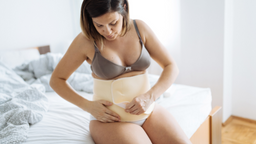If you’ve had shoulder, wrist, back or other muscle pain while breastfeeding, you’re not alone.
Breastfeeding (as well as bottle feeding) requires that we log lots of hours in one or more position, and if those positions set us up for pain, we’re sure to feel it!
We asked Debbie Roberts, an occupational therapist and author of “Preventing Musculoskeletal Pain in Mothers”, to describe some of the more common positions which cause nursing moms pain, and what they can do about it.*
What are the most common areas where nursing moms may end up with musculoskeletal pain?
Nursing moms may be predisposed to develop musculoskeletal pain in their neck, shoulders, forearms, wrist and low back. Pregnancy and the postpartum period place unique strains on a woman’s body. Some of these stressors are related to physiologic changes and others are related to new child care demands.
Picture how pregnancy changes a woman’s posture: abdominal and pelvic floor muscles tend to get overstretched and weak, while anterior shoulder muscles, lumbar paraspinals and hip flexors tend to get short and tight. As a result, a postpartum woman may have a tendency to sit, walk or nurse in a slightly kyphotic posture (picture her neck, upper back and shoulders flexed forward, or rounded). A kyphotic [hunched upper back] posture can lead to neck, shoulder and low back pain.
Postpartum women may also be predisposed to joint pain due to ligament laxity (ligaments that surround and support joints may be overstretched and weak).
Sleep deprivation and pre-existing medical conditions can also pre-dispose nursing moms towards having musculoskeletal pain. For example, hypothyroidism may predispose a postpartum woman towards developing carpal tunnel syndrome.
What are some ergonomic principles nursing moms should know?
Ergonomics is a big topic but a few important ideas can be summarized as follows:
1. Neutral positioning for spine and joints refers to a balanced, comfortable position that avoids musculoskeletal strain. This may vary slightly between individuals.
2. Conserve your energy and rest before you get too tired. Standing uses more energy than sitting. A neutral spine position may feel more restful.
3. Protect your joints. Avoid bending or using your wrist in awkward positions (especially when carrying something heavy or for an extended period of time); protect your low back - avoid bending at the waist with straight legs. If you must carry something heavy, keep the object close to your body and keep your forearms/wrist straight.
Picture the amount of joint stress that a mom would experience if she tried to carry a gallon of milk and a heavy grocery bag with one hand and an infant strapped in a carrier with the other hand. Ouch! This would really strain her wrists, forearms, fingers, shoulders and back.
To protect the joints in her hands, mom should make multiple trips and should take the baby out of the heavy carrier.
Now picture mom, leaning forward to nurse. She’s likely in a slightly kyphotic position, with the baby’s heavy head resting in the web space of her hand. This position puts stress on the mom’s neck, back, shoulders, forearms, wrist and fingers.
In contrast, imagine how mom’s posture changes if she’s sitting in a semi-reclined position and brings the baby up to her breast or if she brings the baby up to her breast.
When semi-reclined or lying on her side, a nursing mom is more likely to have her spine, forearms and wrist in a relaxed, neutral position.
Some moms end up with carpal tunnel pain. What would you suggest they do to relieve this pain?
Carpal tunnel pain is due to entrapment of the median nerve in the carpal tunnel. Symptoms of carpal tunnel syndrome may include numbness, pain, sensory changes and loss of grip strength in the hand.
First, it’s important for the mom to see her primary care provider. She needs to have a diagnosis and plan of care to accurately treat her symptoms and to ensure that she gets long-term follow-up. Her primary care provider may in turn recommend an occupational therapy or hand therapy consult.
Under the care of an MD and therapist, treatment options may include: using NSAIDs (non-steroidal-anti-inflammatoy-drugs) for short-term pain management; use of a custom-made hand splint; home exercise and stretching program; and recommendations for modifying specific activities in her daily routine.
In the meantime, a mom who is experiencing carpal tunnel should avoid prolonged, extreme wrist positions, especially if it involves gripping an object tightly. And get plenty of rest. If a mother finds it too painful to hold her baby with her forearms, laid-back or side-lying positions may provide some relief.
* This post is provided for educational purposes and is not intended as medical advice. If you are are experiencing musculoskeletal pain - especially if it is negatively impacting sleep, daily activities and/or mood - please discuss it with your primary care provider.



